Shams Nafisa Ali
BUET Multi-disease Heart Sound Dataset: A Comprehensive Auscultation Dataset for Developing Computer-Aided Diagnostic Systems
Sep 01, 2024Abstract:Cardiac auscultation, an integral tool in diagnosing cardiovascular diseases (CVDs), often relies on the subjective interpretation of clinicians, presenting a limitation in consistency and accuracy. Addressing this, we introduce the BUET Multi-disease Heart Sound (BMD-HS) dataset - a comprehensive and meticulously curated collection of heart sound recordings. This dataset, encompassing 864 recordings across five distinct classes of common heart sounds, represents a broad spectrum of valvular heart diseases, with a focus on diagnostically challenging cases. The standout feature of the BMD-HS dataset is its innovative multi-label annotation system, which captures a diverse range of diseases and unique disease states. This system significantly enhances the dataset's utility for developing advanced machine learning models in automated heart sound classification and diagnosis. By bridging the gap between traditional auscultation practices and contemporary data-driven diagnostic methods, the BMD-HS dataset is poised to revolutionize CVD diagnosis and management, providing an invaluable resource for the advancement of cardiac health research. The dataset is publicly available at this link: https://github.com/mHealthBuet/BMD-HS-Dataset.
A Web-based Mpox Skin Lesion Detection System Using State-of-the-art Deep Learning Models Considering Racial Diversity
Jun 25, 2023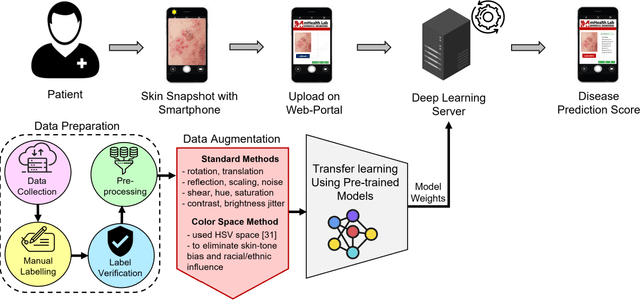
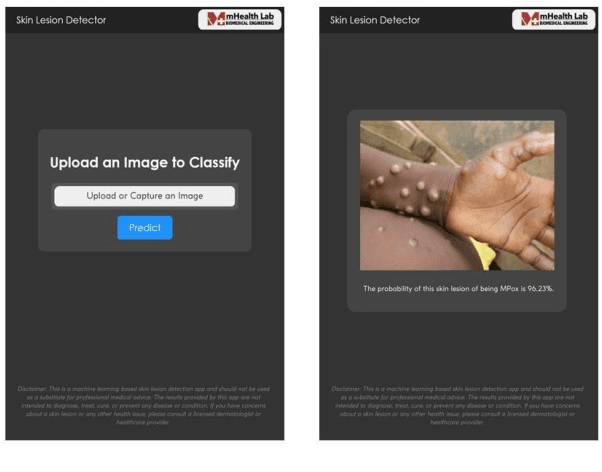
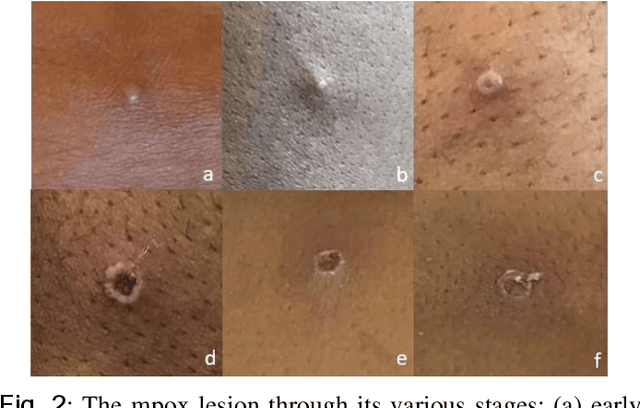
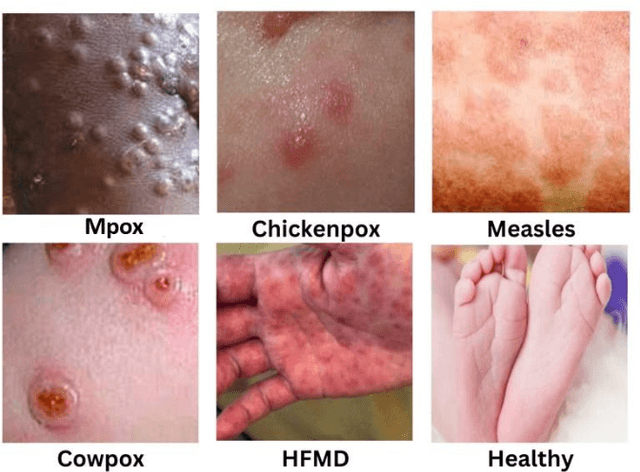
Abstract:The recent 'Mpox' outbreak, formerly known as 'Monkeypox', has become a significant public health concern and has spread to over 110 countries globally. The challenge of clinically diagnosing mpox early on is due, in part, to its similarity to other types of rashes. Computer-aided screening tools have been proven valuable in cases where Polymerase Chain Reaction (PCR) based diagnosis is not immediately available. Deep learning methods are powerful in learning complex data representations, but their efficacy largely depends on adequate training data. To address this challenge, we present the "Mpox Skin Lesion Dataset Version 2.0 (MSLD v2.0)" as a follow-up to the previously released openly accessible dataset, one of the first datasets containing mpox lesion images. This dataset contains images of patients with mpox and five other non-mpox classes (chickenpox, measles, hand-foot-mouth disease, cowpox, and healthy). We benchmark the performance of several state-of-the-art deep learning models, including VGG16, ResNet50, DenseNet121, MobileNetV2, EfficientNetB3, InceptionV3, and Xception, to classify mpox and other infectious skin diseases. In order to reduce the impact of racial bias, we utilize a color space data augmentation method to increase skin color variability during training. Additionally, by leveraging transfer learning implemented with pre-trained weights generated from the HAM10000 dataset, an extensive collection of pigmented skin lesion images, we achieved the best overall accuracy of $83.59\pm2.11\%$. Finally, the developed models are incorporated within a prototype web application to analyze uploaded skin images by a user and determine whether a subject is a suspected mpox patient.
Benchmarking Deep Learning Frameworks for Automated Diagnosis of Ocular Toxoplasmosis: A Comprehensive Approach to Classification and Segmentation
May 18, 2023Abstract:Ocular Toxoplasmosis (OT), is a common eye infection caused by T. gondii that can cause vision problems. Diagnosis is typically done through a clinical examination and imaging, but these methods can be complicated and costly, requiring trained personnel. To address this issue, we have created a benchmark study that evaluates the effectiveness of existing pre-trained networks using transfer learning techniques to detect OT from fundus images. Furthermore, we have also analysed the performance of transfer-learning based segmentation networks to segment lesions in the images. This research seeks to provide a guide for future researchers looking to utilise DL techniques and develop a cheap, automated, easy-to-use, and accurate diagnostic method. We have performed in-depth analysis of different feature extraction techniques in order to find the most optimal one for OT classification and segmentation of lesions. For classification tasks, we have evaluated pre-trained models such as VGG16, MobileNetV2, InceptionV3, ResNet50, and DenseNet121 models. Among them, MobileNetV2 outperformed all other models in terms of Accuracy (Acc), Recall, and F1 Score outperforming the second-best model, InceptionV3 by 0.7% higher Acc. However, DenseNet121 achieved the best result in terms of Precision, which was 0.1% higher than MobileNetv2. For the segmentation task, this work has exploited U-Net architecture. In order to utilize transfer learning the encoder block of the traditional U-Net was replaced by MobileNetV2, InceptionV3, ResNet34, and VGG16 to evaluate different architectures moreover two different two different loss functions (Dice loss and Jaccard loss) were exploited in order to find the most optimal one. The MobileNetV2/U-Net outperformed ResNet34 by 0.5% and 2.1% in terms of Acc and Dice Score, respectively when Jaccard loss function is employed during the training.
Monkeypox Skin Lesion Detection Using Deep Learning Models: A Feasibility Study
Jul 06, 2022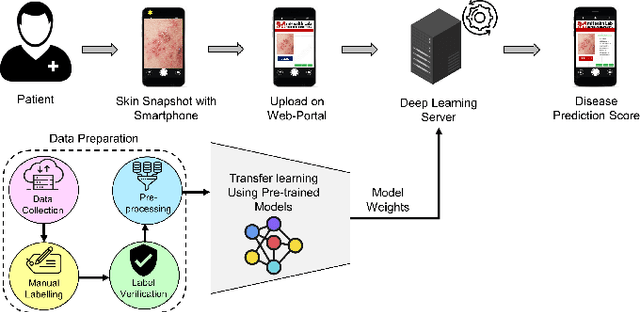
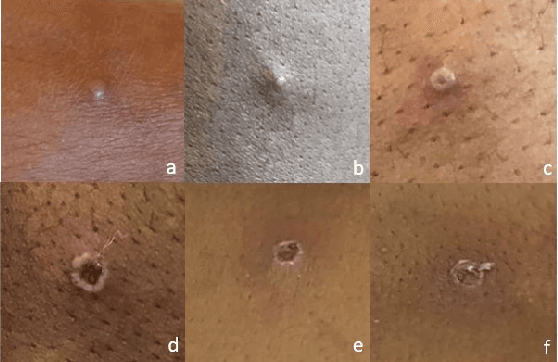
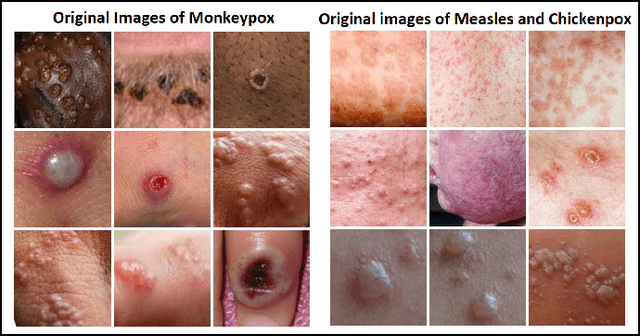
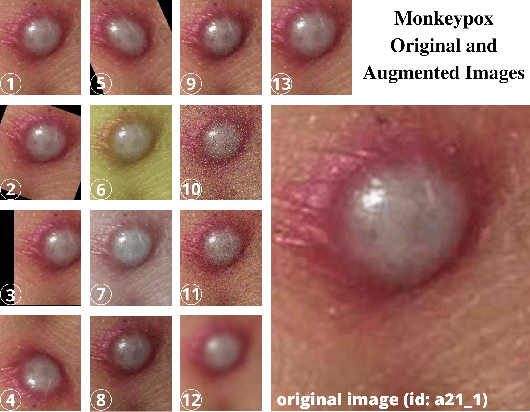
Abstract:The recent monkeypox outbreak has become a public health concern due to its rapid spread in more than 40 countries outside Africa. Clinical diagnosis of monkeypox in an early stage is challenging due to its similarity with chickenpox and measles. In cases where the confirmatory Polymerase Chain Reaction (PCR) tests are not readily available, computer-assisted detection of monkeypox lesions could be beneficial for surveillance and rapid identification of suspected cases. Deep learning methods have been found effective in the automated detection of skin lesions, provided that sufficient training examples are available. However, as of now, such datasets are not available for the monkeypox disease. In the current study, we first develop the ``Monkeypox Skin Lesion Dataset (MSLD)" consisting skin lesion images of monkeypox, chickenpox, and measles. The images are mainly collected from websites, news portals, and publicly accessible case reports. Data augmentation is used to increase the sample size, and a 3-fold cross-validation experiment is set up. In the next step, several pre-trained deep learning models, namely, VGG-16, ResNet50, and InceptionV3 are employed to classify monkeypox and other diseases. An ensemble of the three models is also developed. ResNet50 achieves the best overall accuracy of $82.96(\pm4.57\%)$, while VGG16 and the ensemble system achieved accuracies of $81.48(\pm6.87\%)$ and $79.26(\pm1.05\%)$, respectively. A prototype web-application is also developed as an online monkeypox screening tool. While the initial results on this limited dataset are promising, a larger demographically diverse dataset is required to further enhance the generalizability of these models.
CovTANet: A Hybrid Tri-level Attention Based Network for Lesion Segmentation, Diagnosis, and Severity Prediction of COVID-19 Chest CT Scans
Jan 03, 2021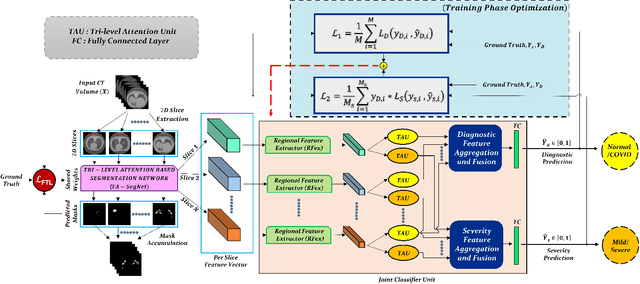
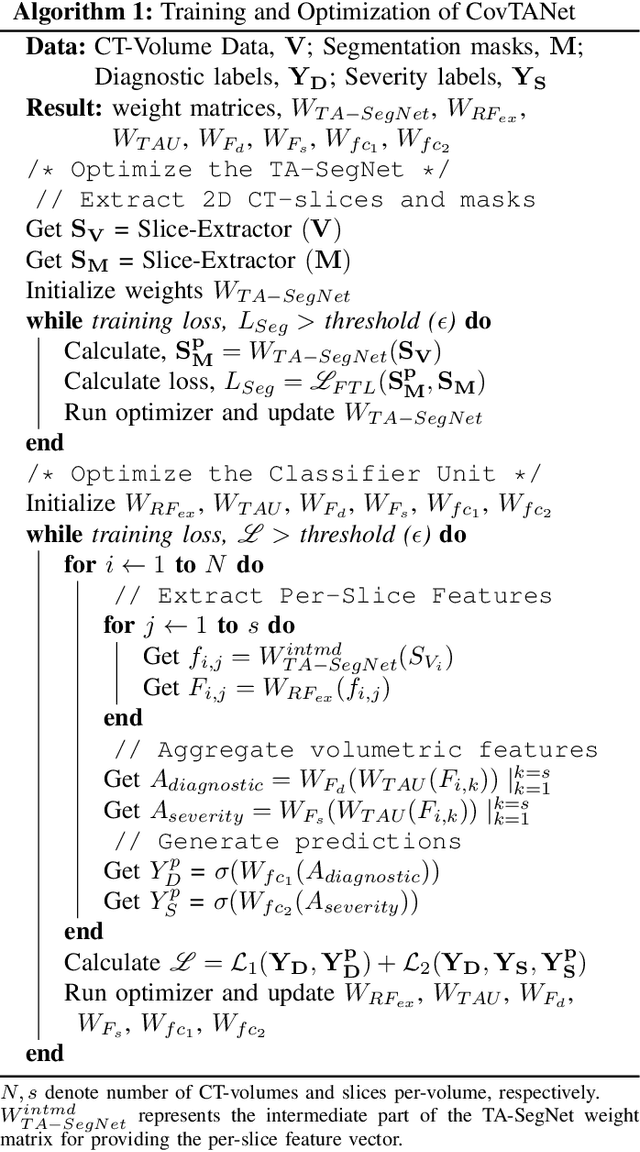
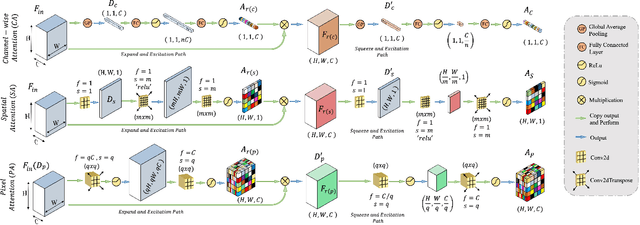
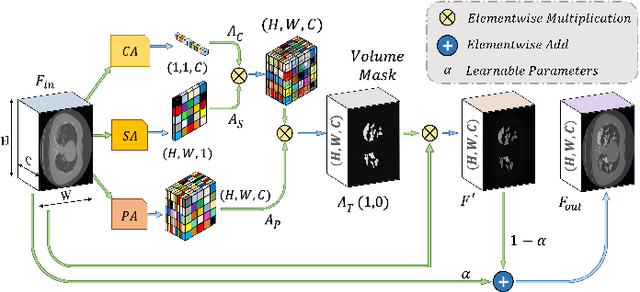
Abstract:Rapid and precise diagnosis of COVID-19 is one of the major challenges faced by the global community to control the spread of this overgrowing pandemic. In this paper, a hybrid neural network is proposed, named CovTANet, to provide an end-to-end clinical diagnostic tool for early diagnosis, lesion segmentation, and severity prediction of COVID-19 utilizing chest computer tomography (CT) scans. A multi-phase optimization strategy is introduced for solving the challenges of complicated diagnosis at a very early stage of infection, where an efficient lesion segmentation network is optimized initially which is later integrated into a joint optimization framework for the diagnosis and severity prediction tasks providing feature enhancement of the infected regions. Moreover, for overcoming the challenges with diffused, blurred, and varying shaped edges of COVID lesions with novel and diverse characteristics, a novel segmentation network is introduced, namely Tri-level Attention-based Segmentation Network (TA-SegNet). This network has significantly reduced semantic gaps in subsequent encoding decoding stages, with immense parallelization of multi-scale features for faster convergence providing considerable performance improvement over traditional networks. Furthermore, a novel tri-level attention mechanism has been introduced, which is repeatedly utilized over the network, combining channel, spatial, and pixel attention schemes for faster and efficient generalization of contextual information embedded in the feature map through feature re-calibration and enhancement operations. Outstanding performances have been achieved in all three-tasks through extensive experimentation on a large publicly available dataset containing 1110 chest CT-volumes that signifies the effectiveness of the proposed scheme at the current stage of the pandemic.
 Add to Chrome
Add to Chrome Add to Firefox
Add to Firefox Add to Edge
Add to Edge